EXPO2005 INTERNATIONAL FORUMS

Culture and Biological Diversity and Internationally Common Recognition
| Overview ![]() | Introduction
| Introduction ![]() | Keynote Speech
| Keynote Speech ![]() | Panel discussion
| Panel discussion ![]() |
|
Panel discussion
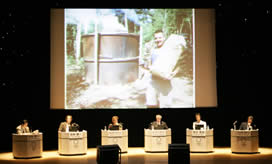
Shin-ichi Takemura, Coordinator
From the perspective of preserving diversity, it is important for us to not only take a scientific approach and build global ties but also to work with local communities and learn from their indigenous knowledge. In this regard, we would like to hear from Professor Abe, UNESCO Expert Meeting coordinator.
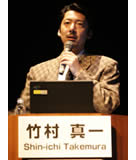
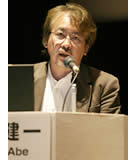
Ken-ichi Abe (Associate Professor, Japan Center for Area Studies in National Museum of Ethnology):
Apparently rich and various food life today is based on “false diversity.” At the same time, natural and cultural diversity is disappearing. And there is unbalanced interdependence between consuming regions and producing regions. We need to change this structural problem. In East Timor in which I am involved, a coffee tree grows freely under shady trees without any use of pesticides nor chemical fertilizers. As a result, such a tree has a lot of greenery compared to the other trees. However, sustainability of this type of production system depends on consumer interest. I would like to stress that building up better interaction among regions will help to preserve biological diversity and environments.
Sandra Lee Morrison (Senior Lecturer, Chair of Department of Maori Culture, School of Maori and Pacific Development, The University of Waikato, Hamilton):
Maoris think that there is a close relation between humans, land and nature. And looking for something sustainable is part of their lives. The concept of sustainability is not new to them. In addition to economic development in the form of mining underground mineral resources, we should think of a model of development by taking advantage of the indigenous view of nature and value there. Maoris need education to survive in the changing world. At the same time, they are expected to play a role on the global stage while taking pride in their tradition. Paradoxically it is important for them to have an open network with other Polynesian nations and the people of the rest of the world in order to restore Mario culture.
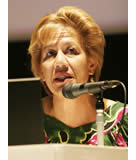
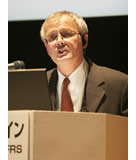
Sir Peter Crane FRS (Professor, Director of the Royal Botanic Gardens, Kew, UK):
For the past 50 years, we have changed our ecosystem very quickly and in a wide range of ways. As a result, we have had irreversible adverse influences on the ecosystem. In order to ensure the future of the Earth, it is necessary to reflect upon what change has happened in the past 200 years and to predict what change will happen in the next 200 years. In this sense, UN's “Millennium Ecosystem Assessment” is an epoch-making event because it focuses not only on nature and life but also on the relationship between human society and nature. The Royal Botanic Gardens, Kew has begun various projects such as its Seed Bank in the framework of the Assessment. In such activities, it is important to tie up with local communities who have kept a variety of seeds, to restore their traditional methods, and to enlighten and educate local staff.
Tetsuya Yomo (Associate Professor, Graduate School of Information Sciences and Technology, Osaka University):
Regarding the issues of diversity and symbiosis, biological experiments have revealed interesting facts. For example, if we experiment on strains of Escherichia coli adding ones that have a variety of metabolic efficiencies earned by genetic variation, highly efficient strains do not necessarily win contrary to our expectations. Some of those with less efficiency are supposed to disappear by natural selection but they do coexist within a certain balance. Even in a predator-prey relationship between slime molds and Escherichia coli, one does not eat up the other completely but they build up a symbiotic network. Unlike machines, biotic systems do not completely optimize themselves nor completely streamline themselves. Leaving fluctuations and diversities, they are strong against environmental change and continue to maintain sustainability in the long perspective.
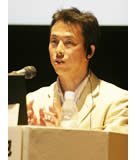
Takemura: As all of us have made comments, we would like to deepen some points at issue further. First of all, I would like to ask if it is possible for global ecology and cultural standards and local ones to live together. I wonder if excessive pressure to standardize anything would lead to a threat to diversity preservation under the recent enhancement of environmental awareness.
Abe: Even one liter of water has quite different meanings, depending on the environmental conditions such as desert, rainforest and city. A privatized water service business is thought to provide the most effective use of water, but should water only be considered as a resource or commercial good? Moreover, we have the framework of emission permit transactions to abate the emission of green house gas under the Kyoto Protocol. According to the framework of such transactions, developed countries give help to plant trees in developing countries to absorb CO 2 in the environment. But the trees planted are uniformly eucalyptus or acacia species. These trees grow very quickly and absorb CO 2 very well, but diversity has been lowered. It is also important for us to see global environmental issues from the viewpoint of local communities.
Morrison:Local knowledge and global knowledge cannot compete with each other. We need to integrate the knowledge of both parties and be prepared to accept a plurality of conclusions.
Takemura: If we see a relationship between local biological/genetic resources and the global economy, we have many problems to solve such as the return of profits or intellectual properties from or of medicines made of a certain drug plant, genetic recombination and genetic contamination.
Crane: Genetic recombination is a difficult problem. Highly intensive agriculture systems require genetically modified crops and irrigation equipment but they often have bad impacts on the environment. On the other hand, if we go back to extensive agriculture systems, they need broad land and may also have bad influences on the environment. The bottom line is how we keep the balance. In our seed bank, we basically exclude commercial crop species and make efforts to collect wild species. Under an international agreement, the Convention on Biological Diversity (CBD), we have a partnership with many countries on formal access and benefit sharing. It is impossible to commercialize this project. However, we have a continuing international discussion on what scope we should apply to the subject of preservation thinking of the long history of crops which have already gone through many hybridizations and improvements.
Yomo:When we see living things, we feel that they are not equal nor they move under the same theory. We tend to say that this is right but it is only right if we measure it by limited criterion and it is not enough when we think of stability as a system and stability in human society. If an individual has a wide cultural knowledge and is free to choose, he can choose not to use a product such as crops that are suspected of being dangerous due to modified gene combinations.
Abe:Genetically modified crops can be subject to patents and they can become the intellectual property of a certain company. But, the original genetic resources, however, are indigenous products without doubt, which local people keep for many years or organizations, such as Kew Gardens, have collected from many regions in the world. If such a product is taken away one-sidedly, and is modified into a new product, what should we do? We should set up a kind of genetic resource pool which may be called “Global Commons” in order to bring down such a product.
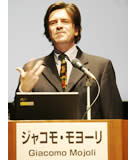
Mojoli:
If genetically modified crops enter agriculture distribution systems in the form of mass products, small-scale farmers and those who are working hard for biological diversity are easily threatened. So, Zimbabwe, Zambia and 17 states of Italy have expressed an objection to genetically modified crops as preventive measures.
Takemura:Moreover, if a certain plant is considered to be useful, preservation of such a plant would be promoted. But, what does “useful” mean in this context? Could the useful plant be judged by the performance only of itself or include the ecosystem around the plant? Or are the local community who know the availability of the plant and their historical and natural perspective included? From another point of view, can we decide the availability only from the dogmatic perspective of human beings? Even if a plant is not useful to human beings, it may be useful to other living things in a different way.
Morrison:The important thing is that indigenous people who live in the community where the crop originates should be given the opportunity to take part in the decision-making process of the future of the crop, in other words, their rights should be properly regarded.
Crane:If more people are going to live in cities in future, we should focus on the habitat environment in and around the city. It is important to see how such an environment will be treated in future.
Takemura:The problem of diversity can be seen as a problem of imagination in itself. If we think of diversification of economy and systems, the problem of diversity is also the problem of how we design our civilization or the problem of our creative ability. If we see the problem in a positive way, we can say that we are in an age when human wisdom is maturing enough to ensure nature's wisdom—diversity. If we realize that human beings can be translators of nature's wisdom, we could design an Earth good for the next era while playing a creative role.


